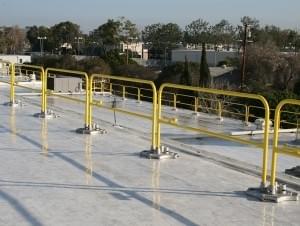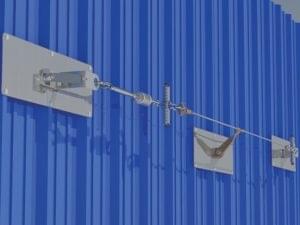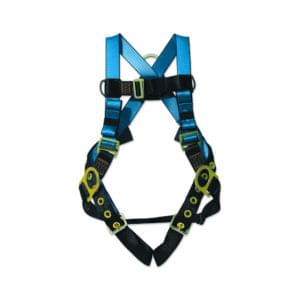Over the past few years, OSHA has been steadily increasing the frequency of its inspections. OSHA carried out more inspections than ever in 2018 (32,000) and recently, Secretary of Labor Jim Acosta went on record saying that he "fully expects inspections to increase" in 2019.
Fueled by the government shutdown and coincidental retirements, OSHA's overall employee numbers were lower in 2018 than the year before. But, they still managed to carry out more inspections. This year, they have already committed to hiring 27 additional full-time inspectors — and they expect to hire 67 by the end of the year. When these new employees are trained and ready-to-inspect worksites, the overall presence of OSHA is going to be even more visible.
With an increase in inspections expected in 2019, we want to take time to talk about rooftop safety. Not only is rooftop safety a critical component of a safe, happy workplace, but gaps in your rooftop safety code can quickly lead to fines and actions from OSHA. To prevent these possible OSHA actions, you’ll need appropriate rooftop fall protection equipment in your facility.
The most common OSHA citation for job sites involving roofing work is the "duty to have fall protection" citation. This has been the case since 2014 when OSHA released its "Protecting Roofing Workers" report, which signified rooftop safety equipment violations as it's number one citation earner. While ladder safety, training, eye protection, and head protection issues can certainly lead to citations, there is an overwhelming number of rooftop job sites that don't have the appropriate safety equipment to protect their workers from potential falls from heights.
The fines that OSHA imposes on those who do not comply with rooftop safety standards can be significant. And, this year alone, OSHA has made a number of rooftop protection fines public. Let's look at a few of them.
Every month OSHA penalizes companies for not complying with safety standards. And keep in mind, your business doesn't have to experience worker injuries to receive a visit from OSHA. They perform random inspections. So, how do you ensure that your company doesn't wind up on this list?
Note: If you operate in California, you must also be aware of CAL-OSHA regulations. Here is a handy guide to help you understand the differences.
OSHA's rooftop safety guidelines are contained in Subpart M of the Title 29 Code of Federal Regulations (CFR). This consists of the following sets of codes.
Let's unpack these codes and talk about what rooftop safety equipment you need to stay OSHA compliant.
Like all compliance issues, there's a bit of nuance packed into this question.
OSHA uses the 6-foot rule to determine when rooftop fall protection equipment is necessary. Any working surface that's elevated at or above 6 feet requires fall protection equipment. While that may seem cut-and-dry, there are a few situations where you would need rooftop safety equipment at elevations below 6 feet.
These are as follows.
But, for most worksites, you need rooftop fall protection equipment when employees are working on a surface 6 feet or higher from ground-level.
OSHA lists three "conventional" fall protection systems. These are:
All work surfaces above 6 feet should utilize one or more of the following depending upon the setup of the site. The most popular type of rooftop fall protection equipment is the guard rail. But, there are circumstances where safety net systems and personal fall arrest systems may be necessary. Also, you can combine two or more of these systems (e.g., using a guard rail system with a personal fall arrest system.)
Let's talk about each of these types of fall protection equipment and which OSHA rules dictate their usage.
Guard rail systems are solid barriers that prevent employees from falling. While there are plenty of varieties of safety railings (e.g., stealthy, penetrating, non-penetrating, etc.) all of them serve the purpose of physically preventing employees from tumbling over a ledge or hole.
 While most of you will end up purchasing safety railings from suppliers that are OSHA-compliant, let's go over their rules regarding a guard rail system contained in 1926.502(b).
While most of you will end up purchasing safety railings from suppliers that are OSHA-compliant, let's go over their rules regarding a guard rail system contained in 1926.502(b).
So, this means that OSHA-compliant safety railings must be 39 - 45 inches in height, contain midrails or mesh, withstand 200 or more pounds at the top 2 inches, and must not be made of plastic or steel banding.
We urge everyone to read the entire OSHA 1926.502 code to see more particulars.
The second conventional safety system is the safety net, which is a netting system that can be used to catch workers should they tumble from a height. Let's go over a few of the OSHA rules surrounding safety net systems.
 There are additional rules regarding connecting safety nets together, mesh lengths, and a diagram of horizontal and vertical distances in the OSHA ebook "Fall Protection in Construction."
There are additional rules regarding connecting safety nets together, mesh lengths, and a diagram of horizontal and vertical distances in the OSHA ebook "Fall Protection in Construction."
Personal fall arrest systems come in many shapes and sizes. One of the most common of these is the horizontal lifeline system (or HLL), but there are additional personal fall arrest systems that you can utilize. Here, we're going to focus on HLL systems. Again, please refer to the official OSHA ruleset here for more information regarding some of the other types of personal fall arrest systems.
 Let's go over a few of the OSHA rules surrounding HLL.
Let's go over a few of the OSHA rules surrounding HLL.
For more information on both HLL systems and other personal fall arrest systems, see here.
For those new to OSHA compliance, rooftop safety equipment may seem overwhelming. The most important thing to remember is that you need adequate training and that you should try to work with a rooftop safety equipment provider that builds OSHA-compliant equipment. And with OSHA inspections expected to rise, there’s no better time than now to make sure your facility is up-to-code.
Do you need a best-in-class guard rail system or HLL system? Contact us. We deliver OSHA-compliant solutions that will help you keep your workers safe.